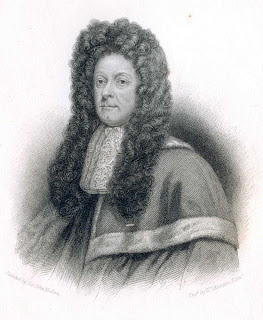 |
| Viscount Stair |
From Sir James Stuart Dalrymple Elphinstone to Sir John Shelley
September 5, 1823.
My Dear Sir John,
"... The bride of Baldoon (for such has always been her designation in our family) was the Hon. Janet Dalrymple, eldest daughter of our greatgreat-grandfather James, Viscount Stair, who was Lord President of the Court of Session in the reign of William and Mary. Janet Dalrymple was sister to the first Earl of Stair, and to our great-grandfather, the Lord President Sir Hugh Dalrymple of North Berwick. She was therefore our great-grand-aunt.
"Janet Dalrymple was deeply attached to Lord Rutherford, to whom she had plighted her troth unknown to her parents. Under the auspices of her mother, a less amiable but far richer suitor appeared in the person of David Dunbar, eldest son of Sir David Dunbar of Baldoon. It was in vain that the young lady not only showed her aversion to his addresses, but also told David Dunbar of her attachment to another, and of the solemn engagement she had made. The new suitor was warmly supported by Janet's mother, and would take no refusal. In these circumstances the poor girl was forced into a marriage which she cordially detested.
"The result of this cruel and unnatural sacrifice was nearly, if not exactly, as related by Sir Walter Scott. On the marriage night, soon after the young couple had been left alone, violent and continuous screams were heard proceeding from the bridal chamber. The door was found to be locked, and, upon being forced open, the bridegroom was found lying on the floor, stabbed and weltering in his blood. In the corner of the large fireplace sat the bride in a state of uncontrollable phrensy. This condition of mind continued, without intermission, until the hour of her death. She did not long survive, and with the exception of the few words, 'Ye hae taen up your bonnie bridegroom,' mentioned by Sir Walter Scott, she never spoke again.
 |
| Sir Walter Scott |
"This is the more probable owing to the fact that young Baldoon—to the last moment of his life— absolutely refused to make any statement whatever. It is more than probable that he was actuated by a desire to conceal the particulars of a rencontre the cause and consequence of which he might well consider as discreditable to himself.
"Lord Rutherford is said to have disappeared immediately after the event took place in a mysterious manner; but that part of the story has escaped my recollection.
"While on this subject I cannot help offering some observations relative to the principal characters introduced in 'The Bride of Lammermoor.' They are all more or less interesting to us both.
"The portrait of Sir William Ashton cannot be regarded as a fair representation of our eminent ancestor, Lord Stair, to whom he bears little resemblance. Sir Walter would seem wishful to avoid any comparison between them when he says that, on acquiring the ancient seat of the Lords of Ravenswood, Sir William had removed certain old family portraits and replaced them by those of King William and Queen Mary, and of Sir Thomas Hope and Lord Stair. . . . Having in the character of Lucy Ashton so closely delineated that of the daughter, the author should, in fairness, have been at more pains to prevent the description of the Lord Keeper from being regarded as an equally fair representation of the father. This is an omission of which the descendants of Lord Stair have, I think, some reason to complain.
"In Lady Ashton the portrait of our ancestress seems to be more faithfully drawn, or at least less misrepresented. She was an ambitious and designing woman, of a masculine character and understanding. It was her fixed determination that her daughter should make that fatal marriage.
"The description of young Ravenswood bears a marked resemblance to that of Lord Rutherford, who was an amiable and high-spirited young man, nobly born, but destitute of fortune. He was certainly well cut out for a hero of romance.
"As to young Baldoon, of whom very little is known, beyond what I have already stated, he seems to have cut a better figure than he deserved in the person of' Bucklaw.' . . .
"So far as Sir Walter Scott's information went— beyond changing the scene of action from the west coast to the east—he seems to have kept to facts as closely as was consistent with a work of fiction. But, if a record of a distressing family incident was to be handed down to posterity in a manner so affecting, and by so renowned an author, it would have been well if the author of' The Bride of Lammermoor' had been made acquainted with a tradition which puts quite a different complexion on the affair.
"I am of opinion that with judicious management the interest of the story would have been increased, and would certainly have left a less painful impression regarding our unhappy and unfortunate relative, the Bride of Baldoon.
"With best regards from all here to you and Lady Shelley, I remain, my dear Sir John,
Ever most truly yours,
James Dalrymple Elphinstone
One of my favorite roles to sing! The last aria in the bloody nightgown, knife in hand was always so much fun!
ReplyDeleteThe Earls of Stair were related to the family of my biographical subject, Grace Dalrymple Elliott.
ReplyDelete